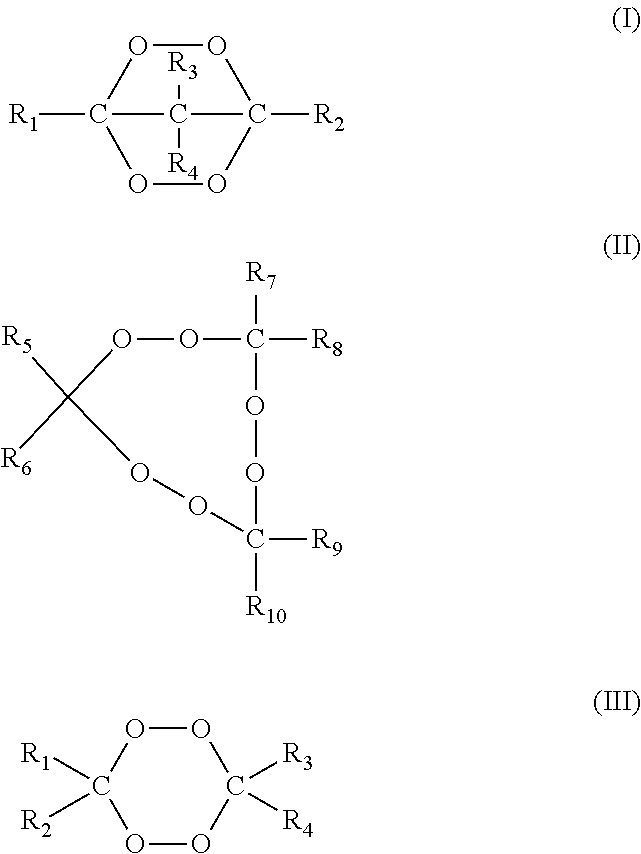Compositions and methods for crosslinking polymers in the presence of atmospheric oxygen
a technology of crosslinking and oxygen, applied in the field of compositions and methods for crosslinking elastomers, can solve the problems of air being excluded, elastomer surface remains uncured, tacky surface, etc., and achieves the effects of reducing the surface tackiness of elastomeric articles, enhancing the desirable surface cure of elastomers, and reducing surface tackiness
- Summary
- Abstract
- Description
- Claims
- Application Information
AI Technical Summary
Benefits of technology
Problems solved by technology
Method used
Image
Examples
example 1
[0348]In this example, the EDPM Masterbatch elastomer formulation in Table 1 and the sulfur vulcanization “control” formulation in Table 2 were prepared. Table 3 provides a summary of five sample runs, which tested various cure systems in the EPDM masterbatch formulation.
TABLE 1“EPDM MB” Masterbatch FormulationIngredientPhrVistalon ® 2504 EPDM100.0N550 Carbon Black100.0Primol ® 352 white process oil40.0PEG Polyethylene glycol3.0Stanguard ® TMQ Powder (antioxidant)1.0Total weight of the masterbatch244.0
TABLE 2Sulfur Vulcanization Control Formulationused to Cure “EPDM MB” found in TABLE 1Masterbatch IngredientParts“EPDM MB”244.0NOTE: 244 PARTS OF “EPDM MB” CONTAINS 100 PARTS OF RUBBER“Sulfur Control” IngredientsPHR (Parts Per 100 Rubber)Zinc Oxide5.00Stearic Acid1.00Sulfur (80%)3.10MBTS (75%)2.20MBT (80%)1.64TMTD (80%)0.31Total Sulfur Control =13.25
TABLE 3Sulfur and Peroxide Formulation Testing of TABLE 1 EPDM MasterbatchSample #12345Parts of “EPDM MB” from Table 1244244244244244phr “...
example 2
[0354]In this example, organic peroxide formulations were used to hot air cure a blend of EPDM and a poly(ethylene α-olefin) copolymer. EPDM can contain from roughly 5% and up to 9% unsaturation, both of which can be crosslinked by sulfur vulcanization. However, sulfur vulcanization cure systems cannot cure saturated polyethylene copolymers like EVA or poly(ethylene α-olefin) copolymers. TABLE 4 provides the generic formulation that was used to evaluate a 54% and 46% blend of an EPDM and poly(ethylene α-olefin) copolymer.
TABLE 4“EPDM + EP Masterbatch”EPDM54Poly(ethylene-α-olefin) 46Carbon Black & Fillers240Process Oil89Total Ingredients429
TABLE 5Standard and Novel Peroxide Formulation testing of TABLE 4 “EPDM + EP Masterbatch”Sample #123456Table 4 “EPDM + 429429429429429429EP Masterbatchphr Vul-Cup ®5.05.05.05.05.06.040KEphr HVA-2 ®2.5—————phr TMPTMA—————3.0phr Vultac ® 52.0——4.5——phr MBTS0.50.670.670.670.67—phr DTDM—4.5————phr Vultac ® 7————4.5—phr CLD-80——4.5———phr total curative1...
example 3
[0358]In this example, organic peroxide formulations were used to hot air cure poly(ethylene vinyl acetate) (EVA). One of the main advantages of organic peroxide cure systems is their ability to crosslink fully saturated polymers. One such useful polymer is poly(ethylene vinyl acetate) or EVA. As shown in TABLE 6, an organic peroxide formulation of the present invention, labeled “SYSTEM-F90,” was used to cure EVA in a hot air oven at 205° C. for 15 minutes, and was compared to a standard organic peroxide formulation consisting of only Luperox® F40KEP.
TABLE 6“SYSTEM-F90”Luperox ® F90P66.67%Vultac ® 526.67%MBTS 6.66%
[0359]The “SYSTEM-F90” peroxide formulation was tested to see if it could successfully hot air cure the EVA Elastomer formulation described in TABLE 7, which is a fully saturated polymer that cannot be sulfur cured. The EVA Elastomer formulation was cured in a hot air oven at 205° C. for 15 minutes with the “SYSTEM-F90” formulation (2.125 phr), and with Luperox® F40KEP (2....
PUM
| Property | Measurement | Unit |
|---|---|---|
| volume capacity | aaaaa | aaaaa |
| volume capacity | aaaaa | aaaaa |
| temperature | aaaaa | aaaaa |
Abstract
Description
Claims
Application Information
 Login to View More
Login to View More - R&D
- Intellectual Property
- Life Sciences
- Materials
- Tech Scout
- Unparalleled Data Quality
- Higher Quality Content
- 60% Fewer Hallucinations
Browse by: Latest US Patents, China's latest patents, Technical Efficacy Thesaurus, Application Domain, Technology Topic, Popular Technical Reports.
© 2025 PatSnap. All rights reserved.Legal|Privacy policy|Modern Slavery Act Transparency Statement|Sitemap|About US| Contact US: help@patsnap.com


